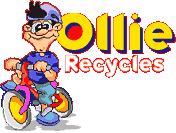|
B. The 3Rs Big Book
Ask pupils to produce a 'big book' telling the 3Rs story for use with younger pupils in their school.
Resources required
- Examples of 'big books' used in the school to help develop literacy.
- Material to produce a 'big book'. This might include, large sheets of different coloured paper, pens, glue, staples etc.
This activity offers a good opportunity for pupils to show how they can reduce, re-use and recycle material in producing the 'big books'. Teachers may therefore
wish to encourage the use of recycled paper and other resources, and collect material that could be re-used by the pupils in making their 'big book'.
Access to a computer with a word processing programme able to print large text would also be useful.
Procedure
Stage 1
The class should have had an opportunity to follow the 3Rs story on the Ollie Recycles CD ROM.
Working individually, pupils are asked to re-tell the 3Rs story in their own words. They should be encouraged to think about the characters, what happens
to them and the message that the story is giving.
Each individual is then asked to work with a partner, or in a small group, and compare stories. Are they similar? Has anybody missed out an important part of
the story?
Each pair or small group should then produce a summary of the story. They may wish to use a computer to write their summary
Stage 2
Pupils are then told that each pair or small group is going to use their summary to produce a 'big book' telling the 3Rs story. When completed, each group
will use their book to read to small groups of younger children in the school.
Examples of 'big books' used in the school should be shown to the class.
The class teacher of the younger children could be invited to talk to the children about what she/he thinks are important features of a good 'big book'.
Each group may be encouraged to firstly list the main points from the story that they would want to include in their 'big book'.
They can then decide how many pages their book will be and what they will put on each page. The page plan sheet included with this activity will help pupils plan their work. Teachers in the school or perhaps a writer of books for children could be used as advisers to the pupils in their task.
Stage 3
Once the pupils are satisfied with their plan they can produce their big book.
An important question to ask the pupils is how can they re-use material for their 'big book'. Teachers could ask pupils to complete the 3Rs Big Book Record Sheet to show how they have tried to re-use material, used recycled material or reduced the amount of material in producing their 'big book'.
The 3Rs Big Book Record Sheet.
In Making Our Big Book We Have:
|
Item
|
Your Answer
|
|
Reduced the amount of materials used by:
|
|
|
Re-used what items?
|
|
|
Used recycled paper?
|
|
|
Used any other recycled items?
|
|
Stage 4
The final stage of this project involves the pupils reading their 'big books' to small groups of
younger children in their school. This could be undertaken as part of a whole school project or linked to an assembly. The 'big books' could also be displayed at a parents evening, in
the school library or in the local public library to reinforce the importance of reducing, re-using and recycling resources.
|



